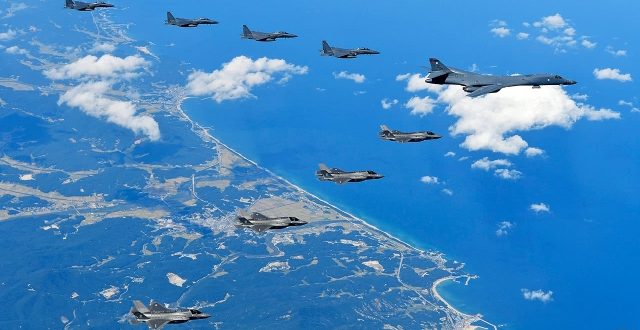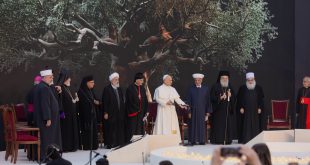MURDEROUS, thin-skinned and in possession of nuclear weapons, the North Korean dictator, Kim Jong Un, has one good deed to his name: he has united America and China. Max Baucus, America’s ambassador to Beijing until January 2017, recalls the Chinese president, Xi Jinping, privately expressing “disgust” at Mr Kim’s reckless pursuit of nukes and missiles to carry them to other continents. Mr Xi’s frustration with North Korea’s hereditary despot stands out as “the strongest statement that I have ever heard Xi make”, says Mr Baucus. China has never sounded as closely aligned with America when it comes to using sanctions and diplomatic pressure, in a last-ditch bid to change how Mr Kim calculates his regime’s interests.
Breaking a long-standing taboo about imagining the Kim regime’s collapse, a well-connected Chinese academic, Jia Qingguo, was allowed to publish an essay in September suggesting that China, America and South Korea should discuss such contingencies as refugee flows and which country’s troops should secure loose nukes in a post-collapse North Korea. Donald Trump hailed China’s role in getting tougher North Korean sanctions through the UN Security Council by unanimous vote. After months of discreet arm-twisting by American Treasury officials with the power to levy huge fines, or exclude them from American markets, Chinese banks are shutting off finance to North Koreans.
Yet the two powers are still capable of blaming each other. Both claim that a nuclear-free Korean peninsula is their highest priority for that region. But American officials have long accused China of placing still more value on stability in North Korea, and thus approving any level of sanctions on the rogue regime short of those painful enough to actually work, starting with a cut-off of oil and other energy supplies.
China, in turn, declares that America is disingenuous to say that its dearest wish is a nuclear-free Korean peninsula, when in truth it is most worried about American national security—explaining why successive presidents from George H.W. Bush onwards have focused not just on the Kim dynasty’s pursuit of nuclear weapons, but on its development of missiles that could carry those weapons to American soil. Nationalist hardliners accuse America of exaggerating the North Korean threat to pursue its real goal, namely corralling China. Other Chinese officials do not go that far, but even the most internationalist argue that sanctions alone cannot solve the Korean crisis. They chide America for refusing to offer the sort of concessions that might conceivably induce the Kim regime to change course, such as a wholesale scaling-back of American military forces in the region and of exercises with South Korean and Japanese allies.
Unfortunately for relations between the world’s two biggest economies, China will hate the next steps that America is likely to take on North Korea. Evan Medeiros, until 2015 the senior director for Asia in Barack Obama’s National Security Council, says that when the Chinese accuse America of refusing to engage in talks with the regime, this is largely “posturing”. But behind it lies a truth, that “sanctions won’t stop North Korea”. When battling the proliferation of the deadliest weapons, sanctions are always in a race with technology, says Mr Medeiros, now with the Eurasia Group, a consultancy. “Kim Jong Un is close to grasping the brass ring. We have probably lost the race and need to think about deterrence.” This could include deploying new missiles and missile-defence systems in South Korea and Japan, and perhaps another aircraft-carrier in the region.
The South Korean defence minister, Song Young-moo, told his country’s parliament that he had asked America to consider the return of tactical nuclear weapons to the Korean peninsula. Tactical nuclear weapons—often meaning smaller, battlefield weapons or air-dropped bombs not covered by strategic arms treaties—were withdrawn from South Korea by George H.W. Bush in 1991, as a prelude to talks with North Korea two years later. At the height of cold-war tensions in the late 1960s and 1970s, there were over 700 tactical nuclear weapons in South Korea, in missiles, bombs and even nuclear landmines, notes Joel Wit of the US-Korea Institute at the Johns Hopkins School of Advanced International Studies in Washington.
Conventional forces will need to be built up if American security guarantees to allies are to remain credible, says Mr Wit. Japan and South Korea must debate their need for everything from anti-missile systems to more offensive weapons, such as missiles and advanced aircraft. That challenges Chinese policy, which is to press America and South Korea to limit the deployment of even defensive weapons, such as the THAAD anti-missile system. THAAD’s powerful radars, installed south-east of Seoul, can see deep into China.
The Senate passed a defence-spending bill in September with $8.5bn to strengthen missile-defence systems. Some of the money would buy 14 new ground-based anti-missile interceptors at Fort Greely, Alaska, taking the arsenal there to 58.
Senator John Barrasso of Wyoming, a Republican member of the Senate foreign-relations committee, reports “a lot of appetite” in Congress for funding anti-missile defences. With North Korea seeking the means to hit American territory with nukes, it would be “malpractice” not to do so, says Mr Barrasso. A member of the Republican leadership in the Senate, he would like to “turn down the heat a bit” on some of the pugnacious tweets from Mr Trump aimed at North Korea. Strikingly, there is no war party in Congress banging the drum for unilateral action. Mr Barrasso sees the Senate stressing work with allies.
Still, cold-war theories of deterrence are being dusted off, with such jargon as “second-strike capability”—the certainty that a country attacked with nuclear weapons can retaliate massively. Douglas Paal, a senior Asia hand in the Reagan White House and both Bush administrations, approves of the Senate plan to place more interceptors in Alaska, in part to gain leverage over China. “We need to layer up more missile defence. China needs to see that their second-strike capacity is really deteriorating, which hurts them.” Mr Paal, who runs the Asia programme at the Carnegie Endowment for International Peace, a think-tank, is in frequent contact with envoys of governments including China’s and, recently, North Korea’s. He concedes the need for talks with the Kim regime, alongside containment and deterrence, but notes that in previous negotiations, North Korea wanted an end to American defence alliances in Asia and to America’s troop presence in South Korea: “So we can’t get there.”
A policy of containment would not just strain relations with China as new American weapons bristled in Asia. Global non-proliferation regimes would be tested, not least because a North Korea facing crippling sanctions might see selling nuclear technology as a lifeline. Perhaps China’s greatest nightmare involves Japan feeling compelled to build nuclear weapons (it could quickly develop the technology). A Chinese build-up of warheads in response could result in India and then Pakistan increasing their stockpiles. The unity fostered by Mr Kim may thus prove short-lived. If he builds the arsenal he wants, China and America will be sincere in their shared dismay. But if America then prepares to contain him, a whole new Sino-American stand-off may begin.
The Economist
 Lebanese Ministry of Information
Lebanese Ministry of Information



